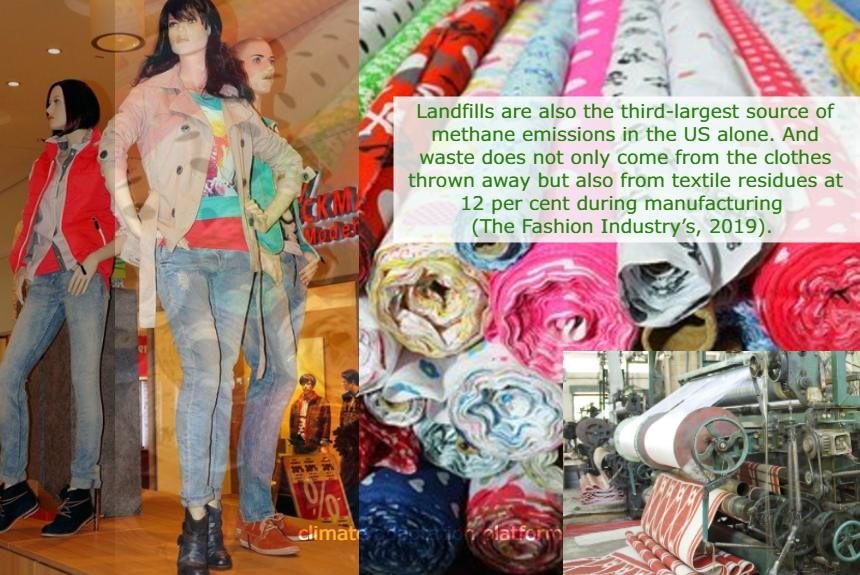The fashion industry is all about clothing trends, or what’s hip or stylish. But rising global carbon emissions are another trend that, if not curbed, is threatening to destroy our environment.
What’s the link between the fashion industry and carbon emissions?
As a billion-dollar industry, it is second only to oil as the most polluting industry. In America alone, there are more than 15 million tons of textile waste each year, of which only around 2 million tons are recycled, 3 million tons are combusted for energy, and 10 million tons are sent to landfills. An average American throws 80 pounds of used clothing yearly (Leblanc, 2019). And these clothes end up in landfills.
If the material is made from cotton, it is easier to decompose, but if it is made from synthetic materials, it takes hundreds of years to decompose in landfills (The Fashion Industry, 2019).
Landfills are also the third-largest source of methane emissions in the US alone. Twelve per cent of waste comes from clothes thrown away and textile residues during manufacturing (The Fashion Industry, 2019). Throwing away clothes and waste from manufacturing creates mountains of waste each day.
Recognising the fashion industry’s contribution to environmental waste and its climate impacts, the United Nations gathered all the industry players, including raw materials producers, textile producers, apparel manufacturers, and big brands, to come up with a cohesive plan to reduce their carbon emissions and identify opportunities to do this. Representatives from all sectors have agreed to reduce their greenhouse gas emissions and put the industry on track to meet the Paris Agreement and the 2030 Agenda for Sustainable Development (Meetings of Fashion, 2030).
As a result, the Fashion Industry Charter for Climate Action was created. This document contains the industry’s vision to achieve net-zero emissions by 2050 (Fashion for Global, 2020). The seven-page document includes the industry’s support of the Paris agreement and its role and commitment to reducing carbon emissions across all sectors (Fashion Industry Charter, 2018).
As consumers, here are some practical things we could do to benefit the environment.
Re-use. Check your wardrobe before shopping for a new dress, shirt, or pants. You may already have one or two good ones you have not used. Re-using your existing wardrobe is always a win-win for the environment and your wallet.
Buy quality clothes that will last and use them for longer. Extending the life of your clothes by 9 months can help reduce water and emissions by around 4-10% (The Fashion Industry, 2010).
Donate to clothes recycling outlets. Using technology and developed chemicals, the industry can now recycle materials made of cotton, polyester, or even blended fibre into usable fibre to make new garments. This reduces waste and creates a circular system (The Fashion Industry, 2010).
Swap or resell. Perhaps you have discovered Facebook Marketplace. It’s a good place to sell or swap your pre-loved clothes, isn’t it?
Buy secondhand clothes. For instance, if you’re a mother with a growing baby or kids, look for online outlets or even local shops that sell secondhand baby clothes and donate your baby’s outgrown clothing to them as well (How the Fashion, 2019). Even though you’re not a mother, buying secondhand, good-quality clothes helps the environment and is also lighter on the pocket.
Our attitudes towards clothing and fashion can affect our shopping practices as consumers. Before buying new clothes on impulse or throwing them away, think twice and consider the impact they will have on the environment.
It is good to know that the fashion industry is recognising its contribution to climate change and taking action.
Let us hope that this trend continues and that all sectors of the fashion industry will take steps to reduce their emissions, manage their waste, and use more sustainable and environmentally friendly materials.
Sources:
Le Blanc, R. (2019, November 4). Textile and Garment Recycling Facts and Figures. The Balance Small Business. Retrieved from https://www.thebalancesmb.com/textile-recycling-facts-and-figures-2878122
The Fashion Industry’s Problem with Waste (2019). Make Good. Retrieved from https://www.makegood.world/fashions-problem-with-waste
Meetings of Fashion Industry Representatives (2020). United Nations Climate Change. Retrieved from https://unfccc.int/climate-action/sectoral-engagement/global-climate-action-in-fashion/meetings-of-fashion-industry-representatives
Fashion Industry Charter for Climate Change (2018). United Nations Climate Change [PDF File]. Retrieved from https://unfccc.int/sites/default/files/resource/Industry%20Charter%20%20Fashion%20and%20Climate%20Action%20-%2022102018.pdf
Fashion for Global Climate Action (2020). United Nations Climate Change. Retrieved from https://unfccc.int/climate-action/sectoral-engagement/fashion-for-global-climate-action
How the Fashion Industry is Responding to Climate Change. (2019, September 2019). Science Friday. Retrieved from https://www.sciencefriday.com/segments/doc-climate-and-fashion/



Leave a Reply